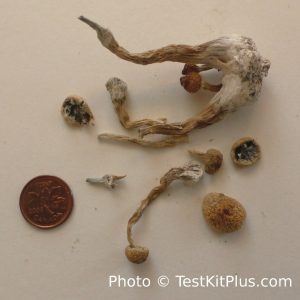Hallucinogenic mushrooms come from the psilocybin mushroom family and cause psychedelic and spiritual experiences, colorful visuals, an altered sense of time, and a feeling of euphoria.
Common street names are: shrooms, magic mushrooms, psychedelic mushrooms, and caps.
What exactly are psychedelic mushrooms?
Psychedelic mushrooms come from the psilocybin mushroom family, containing psilcybin, psilocin, norbaeocystin, and baeocystin- the psychedelic causing ingredients. These mushrooms have been used for centuries and can even be traced back to ancient times around 200 AD where shamans and spiritual healers used them in their daily rituals. These mushrooms are thought to have divine powers, causing many early Christian/Catholic Europeans to reject their use.
Despite its popularity in Mesoamerican culture, hallucinogenic mushrooms were not widely accepted for a substantial period of time. It was not until the 1950s when Caucasians first reported consuming these mushrooms. By the 1970s, these hallucinogenic mushrooms were becoming popular and studied for their possible medical use; however, a ban of “shrooms” occurred shortly after, labeling it a Schedule I drug.

Main effects/side effects
There are three common ways to consume hallucinogenic mushrooms which can produce the well known psychedelic effects: eating them raw, cooking them, or brewing them into a tea. Depending on dosage and preparation, it usually takes 30 minutes or so for the effects to kick in. Once they do, trips can last for up to eight hours. Mood, state of mind, environment, and method of consumption causes the effects of this powerful drug to vary; however, common experiences include: altered thinking processes, colorful and odd visuals, synesthesia, altered views of time, audio distortion, spiritual experiences, and euphoria. It can be difficult to discern reality from hallucinations during and sometimes after tripping. Users may also experience bad trips full of terror and frightening visuals.
“Magic mushrooms” are not known to be addictive, and very rarely are the cause of death. There are no severe long-term physical side effects since these mushrooms are not toxic to the human body, but some long-term mental effects can result from a bad trip. These long-term effects are usually paranoia or hallucinogen persisting perception disorder (HPPD), which are flashbacks of bad trips.
Mushroom varieties and potency
There are a little under 200 hundred known species of psilocybin mushrooms. Psilocybin concentrations vary between mushroom species, as well as within the same species. Different parts of the mushroom also have varied concentrations, with the top part or cap of the mushroom sometimes containing more than double the psilocybin concentration when compared to the “stem” (mycelium).


